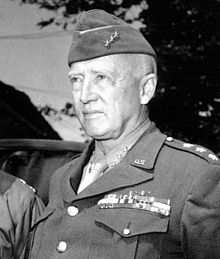Command company Hammelburg
The tank advance to Hammelburg was a US Army operation to free Allied soldiers from the prison camp at the Hammelburg military training area at the end of World War II .
prehistory
On March 23, 1945, the day the 3rd US Army crossed the Rhine under the command of George S. Patton , Patton received the message that his son-in-law John K. Waters was probably in the Hammelburg POW camp . On March 26, a meeting took place between Patton's superiors Dwight D. Eisenhower , Walter Bedell Smith and Patton himself, with Patton mentioning that the 4th Armored Division, with its assault unit Combat Command B, which was closest to Camp Hammelburg, had the Could free prisoners in the Hammelburg camp. Immediately after the meeting, General Smith forbade the commander of the 4th Armored Division, William Hoge, to use Combat Command B for an advance to Camp Hammelburg, because Smith saw no militarily important target in it and he knew the arbitrariness of Patton. When Patton wanted to give Combat Command B the order to attack Hammelburg, he heard of the opposite order and ordered Hoge to assemble at least one small task force from units of his division for the liberation of the prisoners of the Hammelburg camp and to set the unit on the march immediately.
execution
The company was carried out from March 26 to 28, 1945 by the Baum Task Force . Their commanding officer was Captain Abraham Baum. The unit was supposed to advance 80 km behind the German lines from Aschaffenburg and free the Allied prisoners of war in the OFLAG XIII-B camp near Hammelburg . The company ended in fiasco. The US combat group reached the camp, with Patton's son-in-law John K. Waters being injured by a shot in the hip during the fighting at the camp, but the US unit had to withdraw due to the arrival of German units. On the orders of the Chief of Staff of the 7th Army , Rudolf-Christoph von Gersdorff , all currently available German units were brought together to repel the US unit. In the village of Höllrich near Karsbach , the US command unit was enclosed and completely destroyed. The US Army lost all 57 tanks and vehicles used, as well as around 300 soldiers. Most of them went into German captivity . Only seven men could get through to their own lines. Patton put a news blackout on the destruction of Task Force Baum .
On April 5, the 7th US Army finally reached the camp and freed the prisoners of war. Patton sent a plane with a surgeon from his 3rd Army to Hammelburg and had his son-in-law flown out.
Individual evidence
- ↑ Ladislas Farago: The Last Days of Patton. Berkley Books, New York 1982, ISBN 0-425-09881-8 , pages 35-37.
- ^ Rudolf-Christoph von Gersdorff: Soldier in the downfall. Ullstein publishing house, Frankfurt am Main / Berlin / Vienna 1977, page 178
- ↑ Ladislas Farago: The Last Days of Patton. Berkley Books, New York 1982, ISBN 0-425-09881-8 , 38.
- ↑ Ladislas Farago: The Last Days of Patton. Berkley Books, New York 1982, ISBN 0-425-09881-8 , 37.
literature
- Carl O. Schuster: The Hammelburg Raid . In David T. Zabecki: World War II in Europe . Taylor & Francis 1999, ISBN 9780824070298 , p. 1532 ( limited online version in Google Book Search - USA )
- Army & Navy - COMMAND: Patton Legend: More in Time magazine October 15, 1945.
- Richard Baron, Abe Baum, Richard Goldhurst: Hammelburg Command Operation 1945 - General Patton's lost victory . Universitas Verlag Munich 1985.
- Peter Domes, Martin Heinlein: Alarm! The spearhead is coming! Hofmann, Gemünden am Main 2008, ISBN 978-3-932737-07-7 .
- Arno Lustiger : Der Feldherr , Frankfurter Allgemeine Zeitung, No. 299, Saturday, December 23, 1995, supplement "Events and Figures"
Web links
- Tobin L. Green. The Hammelburg Raid Revisited (pdf; 3.4 MB) . Strategic Studies - Research Seminar, July 1994.
- The Hammelburg company
- Extract from Domes / Heinlein Alarm! The armored top is coming (PDF; 1.2 MB)

